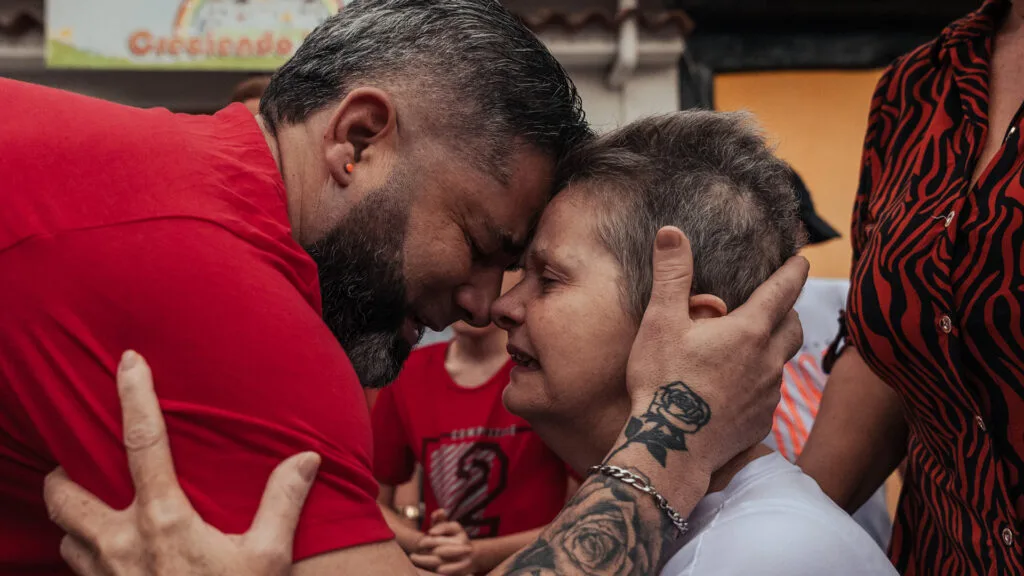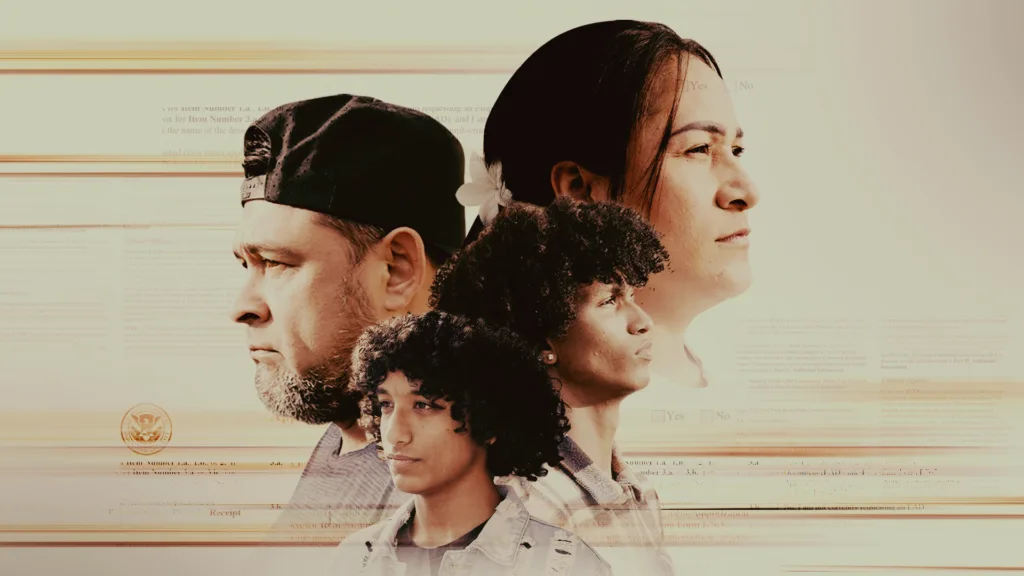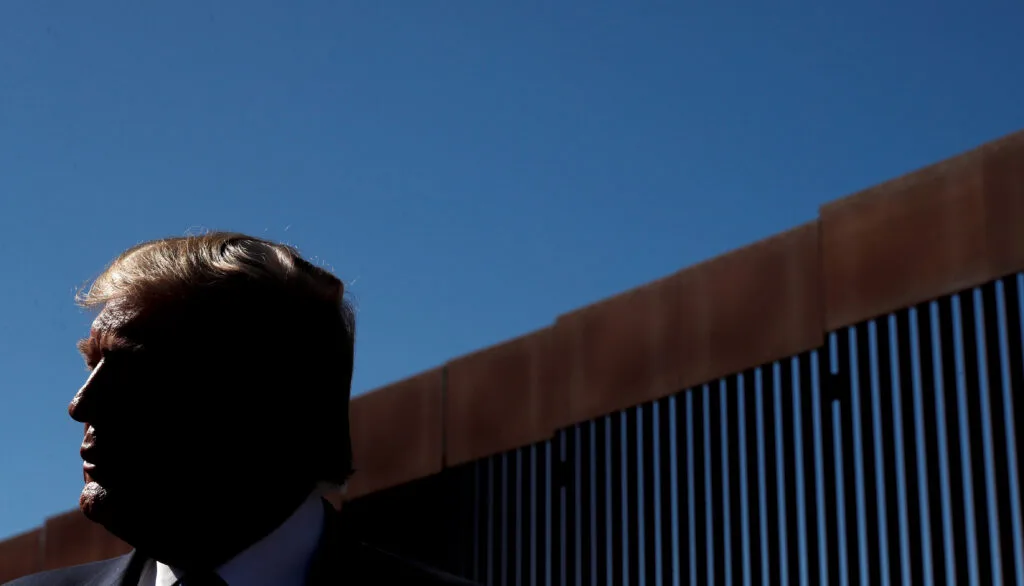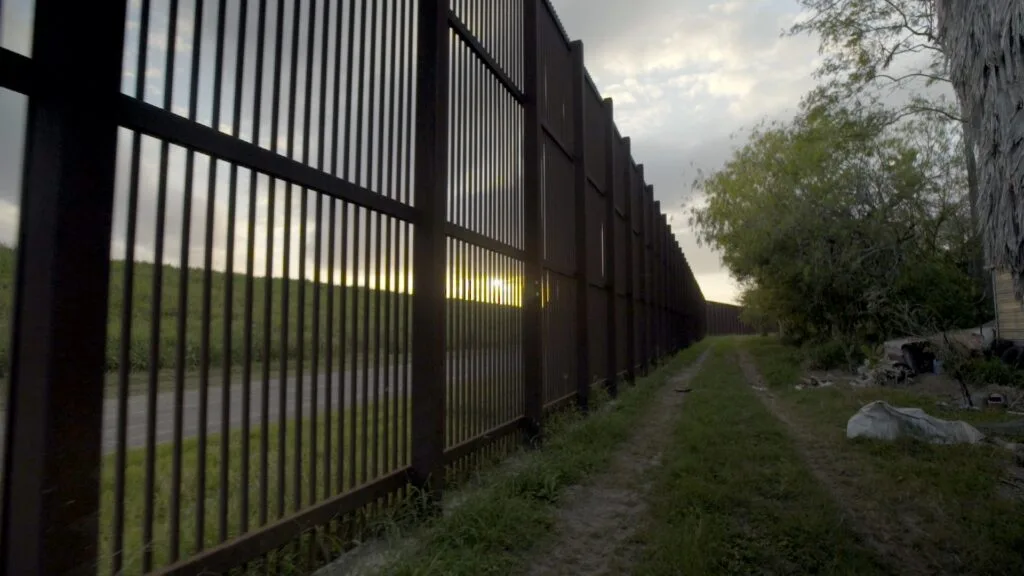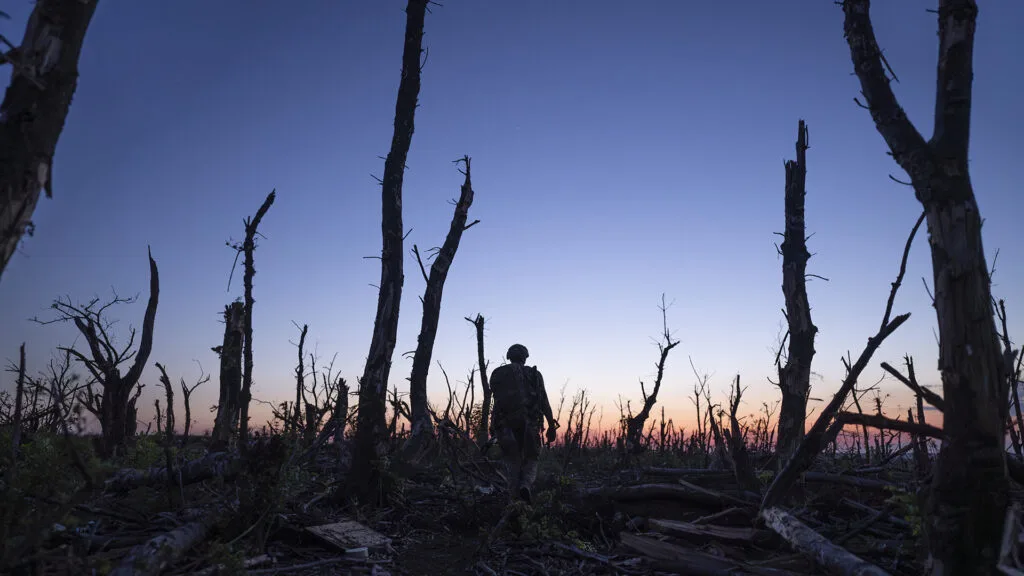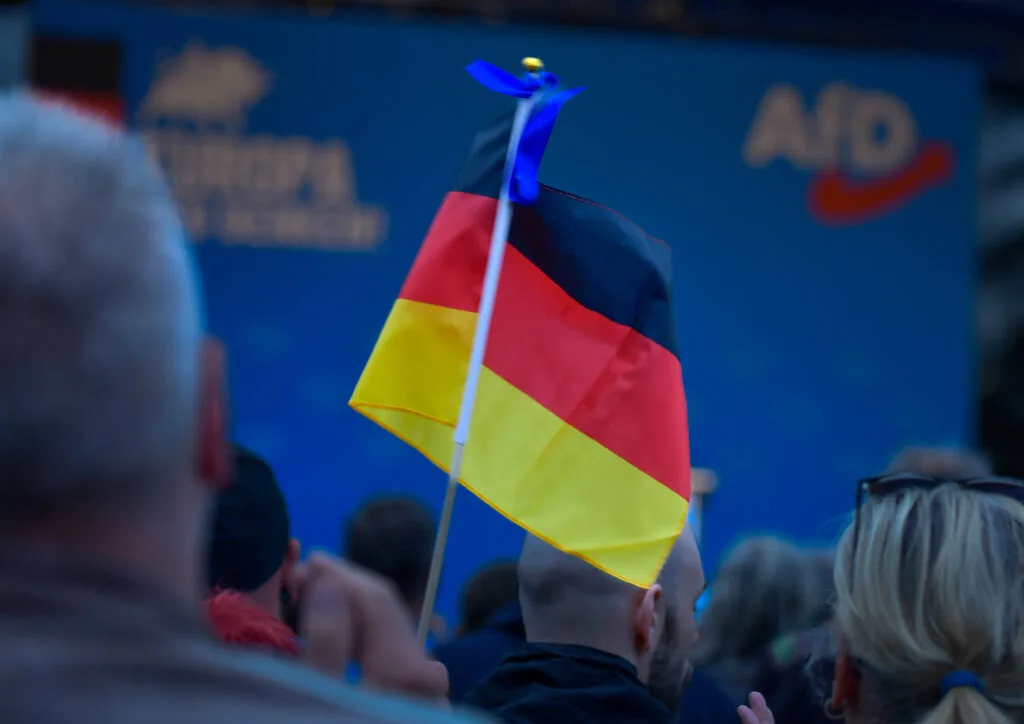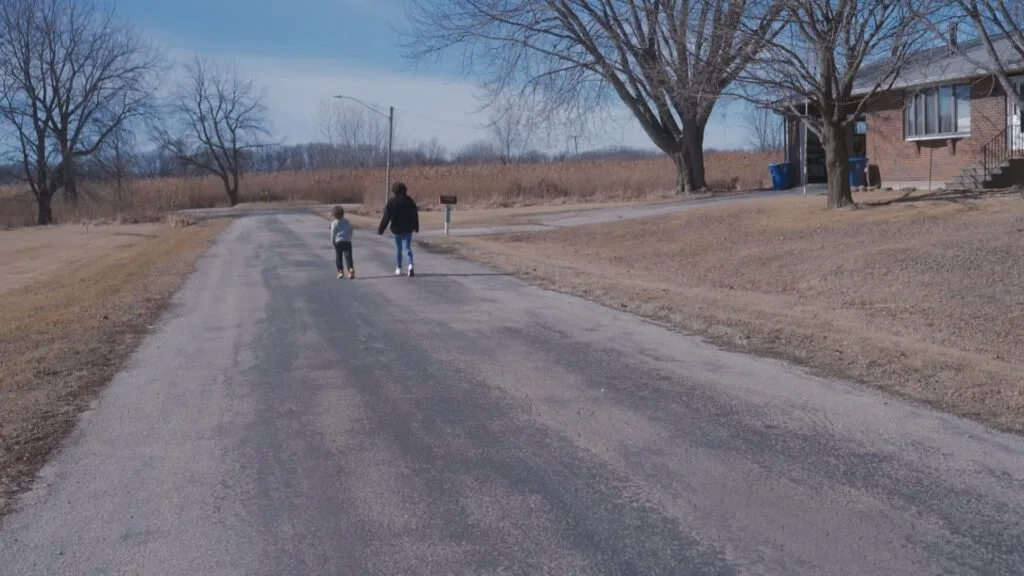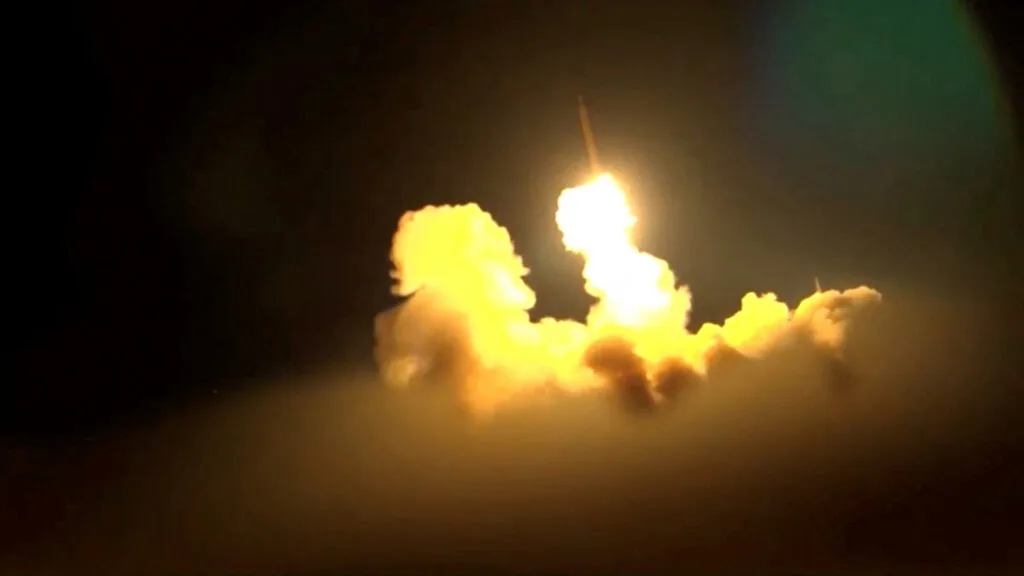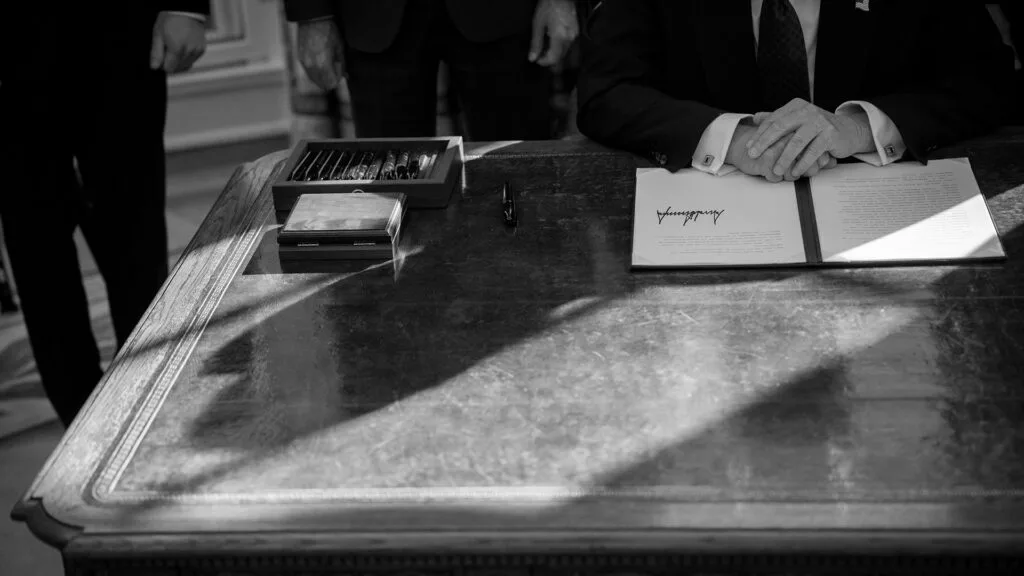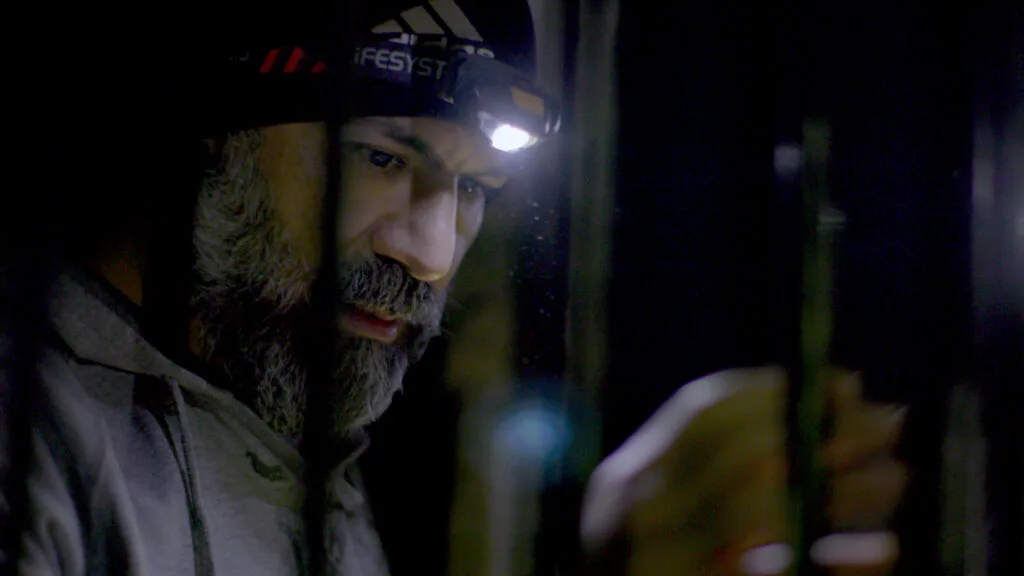Trump’s Immigration Forces Deploy “Less Lethal” Weapons in Dangerous Ways, Skirting Rules and Maiming Protesters
Civil rights and weapons experts cite the consequences of federal agents’ use of crowd control weapons: religious leaders shot with pepper balls and noxious chemicals. A nurse nearly blinded by tear gas. Protestors trapped, struggling to breathe.

November 25, 2025
Share
This story contains videos and photos showing blood and violence against protesters
This story is part of a collaboration between FRONTLINE and ProPublica that includes an upcoming documentary.
As the Trump administration’s immigration dragnet intensified in June, a nurse in Portland, Oregon, left work one midafternoon and drove to a nearby detention facility to voice his opposition. Federal agents had set off smoke grenades, driving away many protesters at the front of the facility, but Vincent Hawkins lifted his megaphone anyway.
“You should stop and think about what you’re doing!”
The shot came seconds later, a silver projectile launched through the small facility’s closed gate, hitting him in the face. The tear gas canister shattered his glasses, ripped apart his brow, crushed against his eye and concussed him. In video footage, the projectile can be seen bouncing off his face and arcing back toward the unknown Immigration and Customs Enforcement agent who fired it.
Hawkins, a 25-year veteran of the emergency room, was rushed to one, bleeding and wondering if he’d ever see through his left eye again. A frequent demonstrator, he knew the risks. He’d seen friends struggling to breathe through toxic chemical clouds, others pelted with pepper balls. But Hawkins was undeterred.
“I have things to say,” he said. “And if it means being wounded to do it, then here I am.”
The 55-year-old said he’d be blind in one eye if not for the shielding effect of his glasses. He’s regained most of his vision but suffers from dizziness and vertigo, sometimes causing him to miss work.

Since President Donald Trump’s administration launched high-intensity immigration sweeps this year, federal agents have routinely countered protestors using crowd control weapons — rubber bullets, flash-bang grenades, tear gas and pepper balls. They’ve fired on American citizens and noncitizens alike in ways that some experts say might be criminal.
The so-called less lethal weapons are designed to break up mobs engaged in dangerous behavior or deter would-be assailants who pose a threat. They aren’t intended to kill. But research has shown the weapons can cause devastating injuries or death. Federal guidelines generally prohibit agents from targeting the head, neck, throat or spine when firing projectiles like rubber bullets or pepper balls.
ProPublica and FRONTLINE conducted dozens of interviews at protest scenes, reviewed hundreds of pages of court documents and photographs, and analyzed some 50 video-recorded incidents in which immigration agents and officers used these weapons in the last five months. That review found more than two dozen cases in which officers deployed the weapons in ways that appear to flout the government’s own rules, including by aiming at someone’s head, spine or groin and deploying chemical agents at moving vehicles or near children.
In Southern California, federal law enforcement fired pepper balls and rubber bullets at people’s heads and backs at least five times, and at least once at a man’s groin, records and interviews show. In Oakland, California, an unarmed pastor who posed no obvious threat was blasted in the face with pepper powder. In Chicago, where more than a dozen people reported being indiscriminately pelted with pepper balls, entire blocks were enshrouded in tear gas, forcing people from their homes. A religious leader was targeted in his head with pepper balls.
Christy Lopez, a former senior civil rights litigator at the Department of Justice, said many of the bystander and news videos she’s seen show “clearly excessive, unreasonable force” that her former office would have investigated as potential crimes.
“They are clearly violating people’s rights,” said Lopez, who now teaches at Georgetown Law. “It’s probably criminal, and it should be investigated as such.”
“I don’t say that lightly,” added Lopez, who led investigations into misconduct and excessive force at police departments including Los Angeles, Chicago and Ferguson, Missouri. “This is a very different situation than anything we’ve seen in the past in terms of just the routine and really brazen use of force in violation of people’s rights.”
Rohini Haar, an ER doctor and University of California, Berkeley professor who studies crowd control weapons, told ProPublica that Hawkins’ assault in Portland was “absolutely” a misuse of tear gas because it was fired at his head when he posed no obvious threat. For a 2023 policy paper published by Physicians for Human Rights, Haar and her team analyzed peer-reviewed medical literature to identify more than 100,000 instances of people wounded by tear gas since 2015; the researchers found more than 5,000 serious injuries, including 14 deaths of people struck by military-grade gas canisters.
Haar said Americans are witnessing a “far more dangerous use of these weapons” in recent months, despite calls for clearer use-of-force policies following the police killing of George Floyd in 2020 and the nationwide protests it spurred.
“You’re going to see a lot more injuries,” she said.
In a statement to ProPublica, a Department of Homeland Security spokesperson said its ICE and Customs and Border Protection officers show “incredible restraint” but sometimes must use force as they “put their lives on the line to arrest murderers, rapists, and gang members.”
ICE and CBP personnel “are trained to use the minimum amount of force necessary to resolve dangerous situations to prioritize the safety of the public and themselves,” the statement said. “Our officers are highly trained in de-escalation tactics and regularly receive ongoing use of force training.”
Even when used correctly, manufacturers acknowledge these weapons can be lethal. As Defense Technology, a Wyoming company that makes the type of canister that struck Hawkins, discloses on many of its wares: “THIS PRODUCT MAY CAUSE SERIOUS INJURY OR DEATH TO YOU OR OTHERS.”
The company did not respond to a request for comment.
Aggressive Campaign
Border Patrol commander Greg Bovino, a 30-year veteran of CBP, has orchestrated many of the most aggressive immigrant roundups across the country.
When forces under Bovino’s command began rounding up suspected undocumented immigrants in Los Angeles in June, vocal demonstrations followed. In response, his troops used tear gas and rubber bullets in ways that drew rebuke from a California federal judge.
On June 7, a Homeland Security agent shot a local reporter in the head with a rubber bullet as the journalist covered a fierce protest at a Home Depot in Los Angeles County, causing a concussion.
In ensuing days, federal personnel repeatedly fired crowd control munitions at media members, protesters and bystanders. The Los Angeles Press Club and a union representing journalists sued the Department of Homeland Security.
“DHS agents have consistently used these weapons to suppress First Amendment protected activity when they faced no meaningful threat of violence,” the suit said. “Despite common perceptions that alleged ‘crowd control’ weapons are harmless, each of these weapons — including, and especially, chemical weapons and projectiles — can cause significant and long-lasting health harms.”
In early September, U.S. District Judge Hernán D. Vera issued an order restricting the use of crowd control weapons and requiring “at least two separate warnings” before agents or officers deployed them. Enforceable only in the Central District of California, which covers much of coastal Southern California, the order also barred agents from firing tear gas canisters and flash-bang grenades at the public and shooting rubber bullets or other projectiles “at the head, neck, groin, back, or other sensitive areas, unless that person poses an immediate threat of death or serious bodily injury.” That order went further than existing policies at DHS, specifically prohibiting firing on journalists and requiring law enforcement to give clear dispersal orders and allowing crowds to leave before deploying weapons.
DHS appealed, saying the ruling “micromanages how DHS agents respond to violent riots.” The appeal is pending.
Bovino has defended his officers, calling their use of the weapons “exemplary.” Yet allegations of misuse have followed his forces to other cities.
Midway Blitz
After Los Angeles, Bovino took his troops to Chicago. There, he led Operation Midway Blitz — an aggressive campaign of roving immigration sweeps that included the siege of an entire apartment building.
Those apprehended during the blitz were taken to a detention facility in a nondescript industrial park in Broadview, a Chicago suburb. Small demonstrations had been held there for years, but they exploded in size as ICE and CBP officials rushed hundreds of detainees through the suburban streets to jail and possible deportation.
Federal agents and officers turned again to crowd control weapons.
Raven Geary, co-founder of Unraveled, an independent news operation in Chicago, was covering a protest at the Broadview detention facility in late September when a federal agent shot her in the face with a pepper ball, causing her left cheek to bleed and bruise.

“It was this very sudden, horrible pain,” said Geary, who was carrying two large cameras and wearing a press badge. Then she realized she was covered in a powder containing the active ingredient in hot peppers. “You’re coughing, you are sneezing, you are wheezing, it can be hard to see.”
Leigh Kunkel, a demonstrator, also got pelted. “The crowd was not doing anything,” she said, yet the pepper balls came flying at them.
Agents shot her in the back of the head and the nose. “I’m incredibly lucky that he didn’t hit me 2 inches higher,” she said. “I could have lost an eye.”
Federal agents firing crowd control weapons during a protest at a Broadview, Illinois, detention facility in September, where journalist Raven Geary was shot in the face with a pepper ball. (Raven Geary/Unraveled)
Kunkel and Geary became plaintiffs in a lawsuit seeking to curb the use of force by federal forces in the Chicago area.
As part of that lawsuit, a nearby resident and mother named Autumn Hamer told a judge how she swung by the facility in the early morning to see peaceful protestors chanting, “Whose streets? Our streets!”
Federal officers on the roof intermittently fired rubber bullets and pepper balls into the crowd, she said. A flash-bang grenade landed next to her, causing disorientation and a ringing in her ear.
At a subsequent protest, she saw a projectile tear through an acoustic guitar a woman was playing. The agents fired tear gas, Hamer said, making her choke. As Hamer and others tried to move from the barricaded front of the facility toward fresh air on another street, she told ProPublica and FRONTLINE, they found themselves getting shot through a side barricade, as though agents had flanked them to box them in.
“It all felt cruel,” Hamer told reporters. She noted that the pepper ball launchers are similar in design to recreational paintball guns. “I have teenage boys, so when I look at [agents], I’m like, … are you pretending that you’re in a video game right now?”
Federal Judge Sara Ellis sided with the plaintiffs, issuing a temporary restraining order that barred immigration agents from targeting journalists and using crowd control weapons unless there is a serious threat to public safety.
Still, Bovino’s agents continued to use the weapons. One Chicago resident captured a video that looks like it could have come from a video game.
Enrique Bahena wore camera-equipped Meta glasses to a protest in Chicago’s Little Village, a largely Latino neighborhood. Bahena said he was with a group of activists who were loudly — but nonviolently — confronting Border Patrol agents. “Everyone was just telling them to get out,” he recalled.
Bahena’s camera glasses captured a first-person view of a Border Patrol agent pointing a pepper ball launcher at him, just feet away. In the video, the agent fires at his throat, sending up a cloud of noxious smoke.
On Nov. 6, Ellis, the federal judge for the Northern District of Illinois nominated by former President Barack Obama, said from the bench that “the use of force shocks the conscience,” before ordering dramatic changes in how federal forces use crowd control weapons.
DHS decried her ruling as “an extreme act by an activist judge that risks the lives and livelihoods of law enforcement officers.”
“Rioters, gangbangers, and terrorists have opened fire on our federal law enforcement officers, thrown rocks, bottles, and fireworks at them, slashed the tires of their vehicles, rammed them, ambushed them, and they have destroyed multiple law enforcement vehicles,” a department statement read.
DHS appealed. Last week, a panel of three Republican appointees sided with the government, temporarily blocking her ruling and saying Ellis’ limitations on officers went too far — so much so, the judges wrote, that they “resembled federal regulation.”

Ellis criticized Bovino for an October incident in which he threw a tear gas canister at community members in the Little Village neighborhood. Bovino claimed he’d been attacked by a rock-throwing assailant, forcing him to deploy the gas for his own protection. Ellis said “video evidence disproves this. And he ultimately admitted he was not hit until after he threw the tear gas.”
Bovino did not respond to a request for comment made through DHS.
A DHS official said personnel working under Bovino enjoy a sense of “impunity” when it comes to uses of force. “These events keep happening because of the lack of accountability by CBP,” said the official, who spoke on condition of anonymity for fear of repercussions. “And there’s usually no repercussions for agents or officers because federal prosecutors rarely prosecute agents for excessive force.”
‘We Come in Peace’
On the morning of Oct. 23, a green-and-white Border Patrol truck lurched through a crowd of protestors gathered on the Oakland, California, waterfront. The demonstrators had converged after learning that federal agents would be using a nearby Coast Guard base to launch a wave of immigration raids.
Masked Border Patrol agents popped out to disperse people who’d enveloped the vehicle with signs and chants. Hoping to calm the tension, a local pastor named Jorge Bautista joined the crowd to pray.
Videos show an agent exiting the truck, marching toward the pastor and pointing a large-caliber weapon at his face.
“I’m thinking, ‘There’s no way he’s going to shoot this thing at me,’” Bautista recalled. “I’m thinking, ‘He’s just using this to scare me. It’s not going to work.’ And the moment I realized he was close enough to hear me, I said, ‘We come in peace.’”
As he said those words, the agent pulled the trigger, striking Bautista with an object that dispersed what bystanders believed was pepper powder. Videos show Bautista struggling to breathe as his eyes and skin burned beneath toxic granules. The unidentified agent calmly returned to the truck.
Bystanders poured liquid on his face. He kept his eyes shut and wound up in the hospital for treatment of scrapes and bruises on his chin and neck.
“No one should be assaulted for being out there protesting,” said Bautista, who said he intends to sue DHS.
“You would figure they would be trained to de-escalate situations, right? Instead of going straight for using some kind of weapon to assault somebody,” the pastor said.
Kirsten Berg contributed research. Gabrielle Schonder and Tim Grucza of FRONTLINE contributed reporting.
Double Your Impact. Protect the Truth.
Bold journalism requires complete independence, and that is only possible with your support. All donations up to $100,000 will be matched. Your gift will go twice as far for FRONTLINE.

Related Documentaries
Latest Documentaries
Related Stories
Related Stories
Explore
Policies
Teacher Center
Funding for FRONTLINE is provided through the support of PBS viewers and by the Corporation for Public Broadcasting, with major support from Ford Foundation. Additional funding is provided the Abrams Foundation, Park Foundation, John D. and Catherine T. MacArthur Foundation, Heising-Simons Foundation, and the FRONTLINE Trust, with major support from Jon and Jo Ann Hagler on behalf of the Jon L. Hagler Foundation, and additional support from Koo and Patricia Yuen. FRONTLINE is a registered trademark of WGBH Educational Foundation. Web Site Copyright ©1995-2025 WGBH Educational Foundation. PBS is a 501(c)(3) not-for-profit organization.

